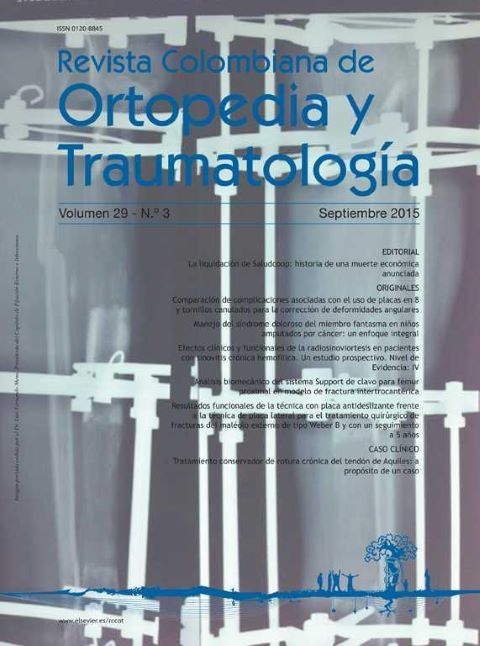Comparison of complications associated with 8 shaped plates and cannulated screws use for the correction of angular deformities
DOI:
https://doi.org/10.1016/j.rccot.2016.02.003Keywords:
idiopathic genu valgum, temporary hemiepiphysiodesis, percutaneous screws, eight-plateAbstract
Background: The epiphysiodesis and hemiepiphysiodesis for correction of angular deformities in the lower limbs has evolved over time and today the use of transient techniques is preferred like are cannulated screws and eight plates. The aim of the study was to compare the outcome of patients with angular deformities treated with cannulated screws and eight shaped plates techniques and determine if there are differences in the outcome of patients.
Methods: A prospective cohort study was performed including pediatric patients treated at the Instituto de Ortopedia Infantil Roosevelt (IOIR) for angular deformities in their lower limbs from 2010 to 2012. A paired comparable cohort of patients in age, sex and diagnosis were assessed in their outcomes. For group 1 (eight shaped plate patient cohort) and group 2 (cannulated screws patient cohort) we evaluated the presence of pain, antalgic limp, edema, infection and inability to fully support lower limbs and crutches requirements.
Results: 6-month postoperative follow-up was performed. It was found in the assessments made in the first month of monitoring the presence of pain in 10 patients for group 1 and in 2 patients for group 2 (p < 0.05). We found that the antalgic limp, swelling, infection and inability to support have no statistically significant differences in the study group.
Discussion: The use of eight shaped plates is associated with the presence of increased pain in the immediate postoperative period in some patients, but this review suggests that a mediumterm pain improvement is seen in this group of patients, therefor not affecting the final clinical outcome.
Evidence level: III.
Downloads
References
Phemister DB. Operative arrestment of longitudinal growth of bones in the treatment of deformities. J Bone Joint Surg Am. 1933;15:1-15.
Blount WP. Control of bone growth by epiphyseal stapling: a preliminary report. J Bone Joint Surg Am. 1949;31:464-78. https://doi.org/10.2106/00004623-194931030-00002
Raab P, Wild A, Seller K, Krauspe R. Correction of length discrepancies and angular deformities of the leg by Blount's epiphyseal stapling. Eur J Pediatr. 2001;160:668-74. https://doi.org/10.1007/s004310100834
Gorman TM, Vanderwerff R, Pond M, MacWilliams B, Santora S. Mechanical axis following staple epiphysiodesis for limb-length inequality. J Bone Joint Surg Am. 2009;91:2430-9. https://doi.org/10.2106/JBJS.H.00896
Bowen JR, Johnson WJ. Percutaneous epiphysiodesis. Clin Orthop. 1984;190:170-3. 6. Canale ST, Russell TA, Holcomb RL. Percutaneous epiphysiodesis: experimental study and preliminary clinical results. J Pediatr Orthop. 1986;6:150-6. https://doi.org/10.1097/01241398-198603000-00006
Metaizeau JP, Wong-Chung JM, Bertrand H, Pasquier P. Percutaneous epiphysiodesis using transphyseal screws (PETS). J Pediatr Orthop. 1998;18:363-9. https://doi.org/10.1097/01241398-199805000-00018
Nouh F, Kuo LA. Percutaneous epiphysiodesis using transphyseal screws (PETS). Prospective case study and review. J Pediatr Orthop. 2004;24:721-5. https://doi.org/10.1097/01241398-200411000-00023
Khoury JG, Tavares JO, McConnell S, Zeiders G, Sanders JO. Results of screw epiphysiodesis for the treatment of limb length discrepancy and angular deformity. J Pediatr Orthop. 2007;27:623-8. https://doi.org/10.1097/BPO.0b013e318093f4f4
Sánchez Mesa PA, Yamhure FH. Percutaneous hemiepiphysiodesis using transphyseal cannulated screws for genu valgum in adolescents. J Child Orthop. 2009;3:397-403. https://doi.org/10.1007/s11832-009-0203-8
Ilharreborde B, Gaumetou E, Souchet P, Fitoussi F, Presedo A, Pennec¸ot GF, et al. Efficacy and late complications of percutaneous epiphysiodesis with transphyseal screws. J Bone Joint Surg Br. 2012;94-B, 270-275. https://doi.org/10.1302/0301-620X.94B2.27470
Stevens PM. Guided growth for angular correction: a preliminary series using a tension band plate. J Pediatr Orthop. 2007;27:253-9. https://doi.org/10.1097/BPO.0b013e31803433a1
Ballal MS, Bruce CE, Nayagam S. Correcting genu varum and genu valgum in children by guided growth. Temporary hemiepiphysiodesis using tension band plates. J Bone Joint Surg [Br]. 2010;92-B:273-6. https://doi.org/10.1302/0301-620X.92B2.22937
Ghanema I, Karama JA, Widmann RF. Surgical epiphysiodesis indications and techniques: update. Curr Opin Pediatr. 2011;23:53-9. https://doi.org/10.1097/MOP.0b013e32834231b3
Burghardt RD, Herzenberg JE. Temporary hemiepiphysiodesis with the eight-plate for angular deformities: mid-term results. J Orthop Sci. 2010;15:699-704. https://doi.org/10.1007/s00776-010-1514-9
Downloads
Published
How to Cite
Issue
Section
License
Copyright (c) 2024 Revista Colombiana de ortopedia y traumatología

This work is licensed under a Creative Commons Attribution 3.0 Unported License.

| Article metrics | |
|---|---|
| Abstract views | |
| Galley vies | |
| PDF Views | |
| HTML views | |
| Other views | |




